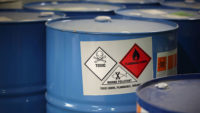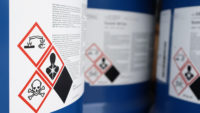OHS pros should know of chemical health and safety risk beyond the basics of what may be found in a safety data sheet. Pros should have a good understanding of each of OSHA’s substance specific standards such as lead, formaldehyde, and asbestos. A good awareness of chemicals most often found in confined spaces is also a necessary. Pros should also know more about chemicals of common interest to the public, than the public knows about these chemicals. Carbon dioxide is a good example.
Knowledge
Hold your breath for thirty seconds. What causes the discomfort as the seconds build up? Most people will say the body is starved for oxygen. Actually, the buildup of carbon dioxide (CO2) causes the discomfort. Inhale oxygen, exhale CO2. If CO2 is not continually exhaled from the body, the molecule will diffuse across the blood-brain barrier and alter the very sensitive pH in the brain. This triggers the brain to force you to exhale. The first sensation from lack of oxygen is often fainting. This is why on airplanes, if masks are deployed from loss of cabin pressure, safety instructions direct you to put on your oxygen mask first before attempting to help anyone else.
Toxic chemical?
Wikipedia’s latest entry states that CO2 is an asphyxiant gas and not classified as toxic or harmful in accordance with GHS. The Renewable Fuels Association, 2015 Carbon Dioxide (CO2) Safety Program states, “We now know that CO2 is a toxic gas – not a simple asphyxiant. In fact, data from the National Institute of Occupational Safety and Health (NIOSH) and other studies show that even in the presence of normal concentrations of oxygen, death will occur at exposures of 7% CO2 in only 5 minutes.” Who is correct?
Interpretation
This is where the OHS pro’s superior knowledge of chemical health and safety risk comes into play. Pros must be prepared to offer risk communication to the public, workers, or others so they more readily may understand chemical risks.
Health risk communication for CO2 may begin something like this: “CO2 is an invisible, tasteless, and odorless gas. There is about 0.04%, or 400 parts per million, of CO2 in the air we breathe. CO2 is not toxic at low concentrations. NIOSH’s short-term exposure limit for CO2 is 30,000 ppm. Short term usually means for 15 minutes. The IDLH or Immediately Dangerous to Life and Health for CO2 is 40,000 ppm. Immediately seek fresh air if the IDLH for CO2 is reached. OSHA has established a Permissible Exposure Limit for CO2 at 5,000 ppm (0.5%) averaged over an 8-hour workday. Workers should be able to breathe this amount of CO2 for an entire working lifetime without experiencing any ill effects. Very old or very young people, or people that may have health problems such as COPD, should avoid high levels of exposure to CO2. Is this too little, or too much, health information to satisfy most people?
High concentrations
OHS pros should always explain where “high” concentrations of harmful chemicals may be found. Risk communication for CO2 may continue as follows: “CO2 is most often used as a compressed gas. CO2 fire extinguishers, for example, are popular because they do not leave a residue, such as ABC fire extinguishers do, on electronics or in food preparation areas after their use. Highly compressed CO2, at about 830 PSI, becomes a liquid and equates to a million parts per million of CO2. Compressed CO2 greatly expands in volume when released. At its release point CO2 is very, very cold, even creating “dry ice” that may cause frost bite in seconds if touched with bare skin. Dry ice is twice as heavy as regular ice. When dry ice warms, it releases CO2. CO2 displaces oxygen which the fire needs to burn, and people need to breathe. CO2 is about 1.5 times heavier than air and may accumulate in low or confined areas. Recall, CO2 becomes toxic at high levels. Immediately seek fresh air if the IDLH for CO2 is reached.” How is our risk communication going? Have we provided too little, or too much, health information to satisfy most people?
Curiosity
Good risk communication should encourage curiosity. The objective of risk communication is not to alarm or diffuse concerns but to reach the point where listeners begin to question how they may remain safe around the chemical. When introductory technical information is finished, such as above, pros should ask listeners questions about the chemical being discussed.
For example, “How has the COVID-19 pandemic increased people’s exposure to carbon dioxide?” If people are stumped with correct answers, offer a hint. “Do some COVID vaccines need to be stored very, very cold?” Once listeners learn that dry ice is being used for this purpose, provide more incentive for curiosity. “In January 2021, the CDC issued Dry Ice Safety for Healthcare Professionals. How many of the safety guidelines can you name?” Add more incentive for listeners to think, as appropriate. For example, “The FAA issued safety guidelines for air transportation of vaccines stored with dry ice. Why is the FAA concerned with a plane’s center of gravity when transporting dry ice? Hint: Dry ice loses weight as it sublimates i.e., changes from solid to gas. FAA regulations require that CO2 concentration during flight must not exceed 5,000 ppm in compartments normally occupied by passengers and crew. How is CO2 measured?” Once people begin to think and ask questions, they are well on their way to safely manage chemical risks.
TMI?
Sometimes OHS pros may offer too much information on chemical risk. You will know too much information is being given when discussions turn political. For example, CO2E, or carbon dioxide equivalents are used to establish the “Carbon Footprint.” The average carbon footprint for a person in the U.S. is 16 tons. The global average is 4 tons. Growing studies suggest that the average global footprint per year needs to drop under 2 tons by 2050 to avoid predicted catastrophes from global warming. The EPA, Nature Conservatory, and other organizations have established online calculations to establish an individual’s carbon footprint. My carbon footprint is above average.
There are many things a person can do to reduce their carbon footprint, such as eating a low carbon diet. Chicken and vegetables, for example, have a ten times smaller carbon footprint, compared to red meat and dairy products. Dry clothes on a line may also reduce your carbon footprint. There is a big push globally for transition to electrical vehicles. OHS pros may greatly contribute to chemical risk communications. Choose your political views on chemical risk communication wisely. Some people may be on edge. For example, see YouTube for what “Rolling coal on a Tesla” means.
Conclusion
OHS pro should continually look for ways to improve their chemical risk communication skills.




